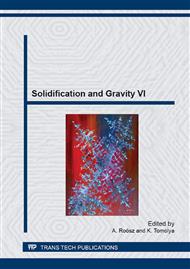[1]
W.K. Krajewski, A.L. Greer, EBSD Study of ZnAl25 Alloy Inoculated with ZnTi4 Master Alloy. Conference Solidification and Gravity IV papers, Materials Science Forum 508 (2006) 281-286.
Google Scholar
[2]
W.K. Krajewski, Determination of Al Site Preference in L12 TiZn3 – base Trialuminides, Conference Solidification and Gravity IV papers, Materials Science Forum 508 (2006) 615-620.
Google Scholar
[3]
P.K. Krajewski, G. Piwowarski, J.S. Suchy, Formulating the Boundary Conditions for Numerical Model of Heat Transfer in a System Heat Source – Heat Sink. Thermal conductivity of the system, Proceedings of Workshop 90 Years of Educating Foundry Engineers by the AGH University of Science and Technology in Krakow, AGH University of Science and Technology, Faculty of Foundry Engineering, Krakow, Dec. 2012, E http: /www. 1odlewnictwo. agh. edu. pl/inne/konferencje/konferencja_2012/abstract/streszczenia. html.
DOI: 10.24917/9788380848511
Google Scholar
[4]
W.K. Krajewski, J.S. Suchy, Determining thermal properties of insulating sleeves, Conference Solidification and Gravity V papers, Materials Science Forum 649 (2010) 487-491.
DOI: 10.4028/www.scientific.net/msf.649.487
Google Scholar
[5]
Y. Jannot, A. Degiovanni, G. Payet, Thermal conductivity measurement of insulating materials with a three layers device, International Journal of Heat and Mass Transfer 52 (2009) 1105–1111.
DOI: 10.1016/j.ijheatmasstransfer.2008.09.017
Google Scholar
[6]
Y. He, Rapid thermal conductivity measurement with a hot disk sensor. Part 1. Theoretical considerations, Thermochimica Acta 436 (2005) 122–129.
DOI: 10.1016/j.tca.2005.06.026
Google Scholar
[7]
C. P. Cam, Measurement of thermal conductivity by differential scanning calorimetry, Thermochimica Acta 417 (2004) 1–4.
DOI: 10.1016/j.tca.2003.12.023
Google Scholar
[8]
S. Chudzik, Measurement of thermal parameters of a heat insulating material using infrared thermography, Infrared Physics & Technology 55 (2012) 73-83.
DOI: 10.1016/j.infrared.2011.09.005
Google Scholar
[9]
J. Svidro, A. Dioszegi, J. Toth, The novel application of Fourier thermal analysis in foundry technologies: Examination of degradation characteristics in resin-bound moulding materials, Journal of Thermal Analysis and Calorimetry 115 (2014).
DOI: 10.1007/s10973-013-3289-7
Google Scholar
[10]
A.I. Vejnik, Theory and calculations of solidification of castings in ceramic mould, Maszgiz, Moscow 1954 (in Russian).
Google Scholar
[11]
L. Carlitz, The Inverse of the Error Function, Pacific Journal of Mathematics 13 (1963) 459-467.
Google Scholar
[12]
A.J. Strecok, On the calculation of the inverse of the error function, Mathematics of Computation 22 (1968)144–158.
DOI: 10.2307/2004772
Google Scholar
[13]
Smithells Metals Reference Book, Eight Edition, Elsevier Butterworth-Heinemann (2004).
Google Scholar
[14]
D. Emadi, L.V. Whiting, M. Djurdjevic, W.T. Kierkus, J. Sokolowski, Comparison of Newtonian and Fourier Thermal Analysis Techniques for Calculation of Latent Heat and Solid Fraction of Aluminum alloys, Metallurgija – Journal of Metallurgy (Serbia) 10 (2004).
DOI: 10.30544/379
Google Scholar
[15]
Z. Ignaszak, Thermophysical Properties of Mould Materials in Aspect of Solidification Control of Simulation Process, Poznan University of Technology, Monograph No. 211, 1989 (in Polish).
Google Scholar
[16]
P.K. Krajewski, Z. Zovko – Brodarac, W. K. Krajewski, Heat Exchange in the System Mould – Riser – Ambient. Part I: Heat exchange coefficient from mould external surface, Archives of Metallurgy and Materials 58 (2013) 847-849.
DOI: 10.2478/amm-2013-0081
Google Scholar
[17]
P.K. Krajewski, A. Gradowski, W.K. Krajewski, Heat Exchange in the System Mould – Riser – Ambient. Part II: Surface heat emission from open riser to ambient, Archives of Metallurgy and Materials 58 (2013) 1149-1153.
DOI: 10.2478/amm-2013-0140
Google Scholar


